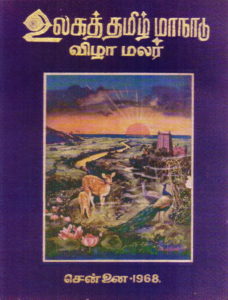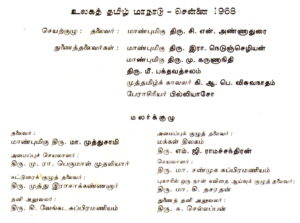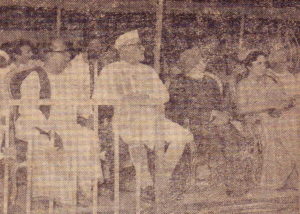2nd International Tamil Conference in Madras, Jan. 1968
by Sachi Sri Kantha, June 20, 2018
My Correspondence with an Indian Plagiarist
I ended the previous chapter that I had sent a mail to the blogger Rama Chandran about his plagiarism, on May 8, 2018. As of that time, I had not heard from him. Well, after that, I did hear from him once. For the record, I present below my initial mail, his response and my 2nd (retaliatory) mail, in sequence.
“May 8, 2018
Hi Mr. Rama Chandran,
Recently, it has come to my attention that you have written about MGR’s father, in a blog.
When I read your description, I find that you had plagiarized material from my still-continuing MGR series (MGR Remembered – in Ilangai Tamil Sangam website) – especially about your references to Erik Barnouw’s ‘Media Marathon‘ book and the English translation of a passage from Arurdhas’s book ‘Naan Mugam Partha Cinema Kannadigal’, without due acknowledgment to the source. These references appeared in chapter 1 and chapter 3 of my series.
You cite 6 references. But, you have tactfully omitted citing my series. I have no qualms about your references 1, 4, 5 and 6.
Best regards.
Sachi Sri Kantha”
I received Rama Chandran’s response on May 14, 2018. It was as follows:
“You are a very mediocre individual, whereas i am an Editor and a Writer. i am a reputed Journalist whereas you are nobody. I wrote the blog several years ago,whereas ypu say you are continuing something. And you have quoted me as plagiarizing not from you, but from other books, and it is evident from your language that you do not know English, and you have stolen from my blog. I don’t read Tamil, and am not a tamilian. You may pay me compensation for stealing from my blog.
Ramachandran”
To this, I replied on May 15, 2018, as follows:
“Hi, Mr. Ramachandran. Thanks for your response. I reply to your diatribe.
I’d say, you have the nerve and chutzpah of an Indian rope trick scoundrel. Here are the facts for your plagiarism.You mention that you wrote that blog several years ago. The fact is that the blog’s posted date says 12th January 2015. Whereas, the two citations which you refer to are
(1) Eric Barnouw’s book ‘Media Marathon’, appeared in my MGR biography series, posted on Dec.12, 2012. Here is the link to this item http://sangam.org/mgr-remembered-part-1/
(2) My translation of scriptwriter Arurdhas book ‘Naan Muham Paartha Cinema Kannaddigal‘, appeared in my MGR biography series, posted on January 20, 2013. Here is the link to this item http://sangam.org/mgr-remembered/
Only in the deluded mind of a plagiarist does Time travel backwards. Now tell me, who plagiarized from whom? Thanks for assisting me, by mentioning that “I don’t read Tamil,” If that’s so, my conviction is proved. Word for word, the English translation of Arurdhas’s description was mine, and not yours.
You brag yourself as “I am a reputed Journalist “. There have been some great journalists and writers from India, whom I admire. These include Mahatma Gandhi, R.K. Narayan and Khushwant Singh. But, not of your caliber chutzpah. I can easily comprehend the quality of your plagiarized journalism in Kerala. As per my background, simply google ‘Sachi Sri Kantha’, and you’ll find out whether I’m a ‘nobody’ or not.
Sachi Sri Kantha”
And I haven’t heard from this plagiarist since then! I take this issue seriously, because as aptly described in a Lancet editorial on plagiarism ten years ago, (1) “Plagiarism is a serious issue for the scientific community; it is intellectual theft, and totally unacceptable.” (2) “Plagiarism undermines the value of research.” Even when I cannot claim any compensation from the plagiarists, at least I have to expose such deeds.
2nd International Tamil Conference

2nd International Tamil Conference, Madras 1968 souvenir cover
As the current entry on C.N. Annadurai, the leader of DMK party, in the Wikipedia (accessed, June 20, 2018) doesn’t provide any details about the 2nd International Tamil Conference, held in Madras from January 3rd to 10th 1968 under his leadership, to mark its 50th anniversary I provide some available information gathered from my files. While MGR doesn’t make any mention in his autobiography about this Tamil conference and his contributions to its success, Karunanidhi had allocated 4 pages to it, in his autobiography. Passingly, in one sentence, Karunanidhi also had noted,
“a sweet news reached me that to my companion Raji (now known as Rajathi Amma; his third wife) who had joined me in activities in arts and of party, our symbol of love, Kanimozhi, was born.”
50 years have passed, since Kanimozhi’s birthday on Jan.5, 1968. Rajathi Amma was a stage and radio actress in 1960s. Poet and lyricist Vaali had mentioned in his memoirs, that Rajathi Amma was also known as Miss Dharma or Mrs. Dharmambal, and she had helped him in a short notice (within a day), to play the role abandoned by another stage actress, for a drama penned by him.
Karunanidhi’s brief description, and news features that had appeared in the Senthamil Selvi monthly magazine during 1967 and 1968, present some details related to this conference. Over 200 foreign delegates had visited Madras to present their research papers and deliberate in the discussions. From India itself, there were 190 academics from Tamil Nadu and another 30 academics from other states. Though these presentations took place at the University of Madras, DMK regime led by Anna had felt that Tamil public also have to be accommodated to delight themselves in felicitating ‘Mother Tamil’. As such, for their benefit, opening day processions with floats depicting the Tamil culture, ‘opening’ of statues for the great contributors to the Tamil culture, poetry presentations, debates, and art exhibitions were also organized. Due to such arrangement, Chennai city was in a festive mood for little more than a week.

1968 Tamil Conference Souvenir Committee
Though the official opening of the Conference-Seminar was slated for January 3rd by the then president of India, Dr. Zakir Hussain, two days ahead, on January 1st, Anna’s statue (located in the Mount Road, now known as Anna Saalai) was opened by Dr. A Ramaswamy Mudaliar. Though Karunanidhi had described this in a paragraph, the fact that MGR had donated this Anna’s statue was deftly omitted, by design or carelessness.
The following day (January 2nd), ten additional statues for notable personalities (Tamils and non-Tamils) who had significantly contributed to Tamil culture, positioned in different locations of Marina Beach was opened. In chronological order, these personalities were,
Kannaki – ancient heroine of Tamil epic Silapathikaram (~ AD 100).
Tiruvalluvar – ancient Tamil poet and ethicist, (circa AD 5th cent.). This statue was
donated by actor Sivaji Ganesan.
Avvaiyar – ancient and medieval Tamil poetesses and ethicists, now recognized as two
individuals who had lived in the 3rd Sangam period and 12th cent. AD.
Joseph Constantine Beschi aka Veerama Munivar (1680-1742) – Italian Jesuit priest.
Bishop Robert Caldwell (1814-1891) – British missionary and linguist.
George Uglow Pope (1820-1908) – Canadian missionary and Tamil scholar.
V.O. Chidamparam Pillai (1872 -1936) – freedom fighter, attorney and shipping
magnate.
Subramania Bharathi (1882-1921) – Tamil poet, journalist and freedom fighter.
Bharathidasan aka Kanaka Subburathinam (1891-1964) – Tamil poet and Tamil
nationalist.
All ten were not among the living, but Anna was a living individual. Expectedly, some Tamil traditionalists did mumble in muted voices and criticized here and there, about initiating a trend of erecting statues to living individuals, whatever noteworthy was Anna’s contribution to Tamil culture.

Anna (left) with President Zakir Hussain at the Opening Ceremony, 1968 Jan 3
On January 3rd, at the function presided by Chief Minister Anna, DMK party graciously allowed the Congress Party leader K. Kamaraj to deliver the opening welcome address. In his address, Kamaraj stated,
“The first international Tamil Conference should have been held here. But, the Malaysian Tamils had beaten us to that. While attending the first conference in Malaysia, the then Chief Minister M. Bhaktavatsalam offered to host the 2nd Tamil Conference in Tamilakam. This Conference should be a success. Wherever Tamils live, they should hold their heads high.”
In the photo taken on that occasion (presented nearby, that had appeared in the Anna memorial issue of Ananda Vikatan weekly of March 30, 1969), from left to right, one can notice Anna with a black shawl, Dr. Zakir Hussain (President of India), Mr. Ujjal Singh (Governor of Madras State), probably Mrs. Ujjal Singh and M. Bhakthavatsalam (in a blurred image).
Other welcoming addresses were delivered by R. Nedunchezhiyan (Minister of Education) and by Minister Sathyawani Muthu (Minister of Harijan Welfare and Information, on behalf of Tamil women). As a leading member of the committee in charge of its production, MGR released the felicitation volume of the Conference and delivered his address. He also contributed an introductory article to this felicitation volume, which I present nearby in PDF. In addition, in a function presided by R. Nedunchezhiyan, MGR awarded the first three prizes for the winners of the ‘One Day at Puhar’ poetry competition.
MGR’s Introductory article to 1968 Felicitation volume
Karunanidhi also recorded that the movie magnates of Chennai, namely S,S. Vasan, A.V.Meiyappan Chettiyar, Nagi Reddy and A.L. Srinivasan rose to the occasion and contributed much in recording the festivities in film roles cum documentaries. And it was his honor and pleasure to write the script and speak in these documentaries. After listening to his poetic description in Tamil, S.S. Vasan could express his pleasure by hugging and planting a kiss in his forehead. The procession filmed during this conference was later released for public viewing, and did make substantial profit for the Tamil Nadu government. Then, it was decided to make use of this profit, by erecting a statue to N.S. Krishnan, the renowned Tamil stage and movie comedian and DMK’s benefactor during its growth stages. This statue, produced at a cost of 20,000 rupees was opened by Anna on the Pongal day of January 1969, which turned out to be the last public function Anna took part, prior to his premature death on February 3rd.
In 1981 (13 years after 1968), MGR had another opportunity to be in charge of the 5th International Tamil Conference-Seminar, held in Madurai, as Tamil Nadu’s Chief Minister. Both Nedunchezhiyan and Sathyavani Muthu also had joined MGR’s party subsequently. Karunanidhi (then Leader of the Opposition), played a spoiler role in boycotting the 1981 Tamil Conference.
Attracting the Masses and the Significance of Processions
This is an opportune moment to criticize the myopic views of Pandian, a noted MGR’s biographer and critic, on the attraction of masses to MGR. According to Pandian,
“Virtually every one of MGR’s public appearances through what one may call ‘rituals of consecration’. The ‘rituals of consecration’ are part of the process of reinforcing and authenticating in real life his aura on the screen.
Turning to these rituals, one should begin with processions. The DMK and the AIADMK party processions have been, to say the least, carnivalesque and inthem MGR was taken out from time to time as if he was a crowned king…”
Pandian’s gripe against the party processions is somehow misplaced. The patent for involving masses in walking and disobeying the law enforced by oppressors, was held by none other than Mahatma Gandhi. In his haste to critique DMK, and subsequently its offshoot AIADMK founded by MGR in 1972, Pandian had ignored the mass participation movements organized by Gandhi on April 6th, 1930, against the British imperialists. It came to be known as Dandi Salt March. On Gandhi’s unusual strategy of using the ‘lowly’ salt as a powerful, protest weapon against the British administration, this is how Nehru had presented his thoughts in his ‘Autobiography’ in 1936.
“Salt suddenly became a mysterious word, a word of power. The Salt Tax was to be attacked, the salt laws were to be broken. We were bewildered and could not quite fit in a national struggle with common salt…
The 6th of April was the first day of the National Week…On that day Gandhiji began the breach of the salt laws at Dandi beach, and three or four days later permission was given to all Congress organizations to do likewise and begin Civil Disobedience in their own areas…
As we saw the abounding enthusiasm of the people and the way salt making was spreading like a prairie fire, we felt a little abashed and ashamed for having questioned the efficacy of this method when it was first proposed by Gandhiji. And we marveled at the amazing knack of the man to impress the multitude and make it act in an organized way.”
Pandian had presented an example of a 1959 parade organized by DMK party to felicitate the 100-day run of MGR’s own movie, Nadodi Mannan, in which MGR was treated like a ‘king’. When considering the context of that period, DMK was an ‘unregistered’ political party in 1959. To attract the attention of Tamil masses it protested against Nehru administration’s high handed acts from New Delhi as well as Congress Party rule in Madras State, by borrowing Gandhi’s lesson of 1930; via a vicarious strategy of celebrating MGR’s own movie that advocated regime change in its plot.
Eight years later (partly by means of such mass participation and mass education via movie scripts, story plots and songs), the pendulum had swung to opposite direction, and DMK had captured the state legislation. One may interpret the 1968 mass procession organized during the 2nd International Tamil Conference, was itself a ‘Thank You’ act to the Tamil masses by the DMK government. Certainly, it was one of the crowning moments for Anna’s truncated regime of less than two years. In 1968, having reached 51, MGR made himself busy in producing his second EmGeeYar Pictures production Adimai Penn [The Slave Girl], while also learning the ropes of a rookie politician at the State Assembly.
Cited Sources
Editorial: Fighting plagiarism. Lancet, 2008 June 28; 371: 2146.
Kalaignar Karunanidhi: Nenjukku Neethi [Justice to the Heart], vol.1, 2nd ed., Thirumagal Nilayam, Chennai, 1985, pp. 723-726.
M.S.S. Pandian: The Image Trap: M.G. Ramachandran in Film and Politics, Sage Publications, New Delhi, 1992, p. 113.
MGR: Naan Yean Piranthen? [Why I was born?] Parts 1 and 2, Kannadhasan Pathippagam, Chennai, 2014.
Jawaharlal Nehru: An Autobiography, Oxford University Press, New Delhi, 6th Impression, 1988 (originally published in 1936), pp. 210 and 213.
Second International Tamil Conference-Seminar – Notes. Senthamil Selvi, Dec. 1967, pp. 56-59.
Second World Tamil Conference Issue. Senthamil Selvi, Jan. 1968, pp. 45-73.
Lena Tamilvanan (ed.): Kalaignar M. Karunanidhi, Manimekalai Pirasuram, Cennai, revised 2nd ed., 1994.
Kavignar Vaalee: Naanum Intha Nootraandum [The Century and Me], Kalaignaan Pathipagam, Madras, 1995, pp. 124-125.
Thanks Dr. Sachi for recording the historic details of second International Tamil Conference in Madras.
You have also exposed the ill-will of Mr. Pandian towards MGR by pointing out that the art of ‘rituals of consecration’ were already perfected by Gandhi long before MGR.